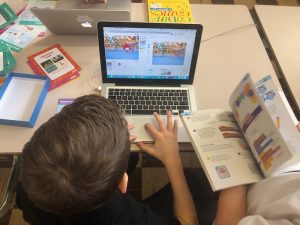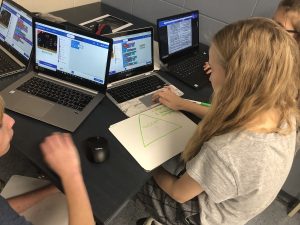Digital Devices
Digital devices – like chromebooks, laptops, iPads, and other tablets – are tools that can make learning more interactive. Teachers and students use them as tools to record their learning processes, create unique artifacts like videos or other student productions, and easily access information as needed. Not sure which device to use? Here is an infographic to help you determine which device best suits your situation.
Digital devices are essential for any experimentation with robotics and many of the activities that take place in an open creative space.
Devices such as computers and tablets, along with other materials, can be used for creating, researching, and documenting a student’s process in a creative space or classroom. For example:
- creating animation (claymation, Lego, green screen)
- digital storytelling
- creating games with programming tools such as Scratch 3.0
- finding information, examples and projects that others have posted online
- documenting work in process through photos and videos and written notes in a reflective journal or portfolio
- creating and publishing how-to videos or web pages that can be useful to others
- connecting computers and the physical world using microcontrollers such as the Makey Makey and Micro:Bit
- sharing process and creations with others through blogs and social media
- networking with others who are working on similar projects
 Perhaps most importantly, digital devices are tools with which teachers, students, parents, caregivers, and community partners can communicate with each other about learning. Having a diverse selection of devices available in a school or centre is ideal so that students and teachers can choose the device they need based on the learning goals and tasks at any given time.
Perhaps most importantly, digital devices are tools with which teachers, students, parents, caregivers, and community partners can communicate with each other about learning. Having a diverse selection of devices available in a school or centre is ideal so that students and teachers can choose the device they need based on the learning goals and tasks at any given time.
Stations-based teaching and blended learning
 Teaching in stations allows learning to happen in small groups. When using a station-rotation model, where learners rotate through different stations including a teacher-station, teachers can touch base with small groups of students at a time while the rest of the class is busy actively engaged with other activities – and each other. This is an excellent way to structure the use of digital devices in a classroom so that small groups of students are using them at any given time.
Teaching in stations allows learning to happen in small groups. When using a station-rotation model, where learners rotate through different stations including a teacher-station, teachers can touch base with small groups of students at a time while the rest of the class is busy actively engaged with other activities – and each other. This is an excellent way to structure the use of digital devices in a classroom so that small groups of students are using them at any given time.
This video describes how Lindsay Harrar, a second language teacher at ACCESS Adult Centre of the Riverside School Board, uses stations. She talks about the role of digital devices in the learning process during one of her lessons.
Flexible Classrooms
Digital devices are essential elements of a flexible classroom space. Many teachers have begun to design their classrooms to offer more choices to students regarding where and how they learn. In some flexible classroom spaces, devices are spread out in different areas of the room, and in other rooms, there are specific zones for using digital devices. It all depends on what works best for you and your students in relation to the learning intentions.
- What are my learning intentions and which devices will help my students or adult learners within this context?
- What kinds of devices will best support the activities within my discipline? (for example, writing may be done better on a chromebook or laptop while creating video may be done better with a tablet.)
- How are the devices facilitating conversation between students?
- Am I allowing for student choice in regards to which devices they use?
- How will I design my classroom environment to support the use of different digital devices?









